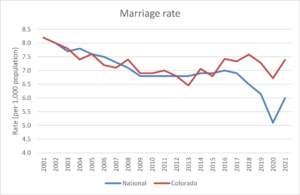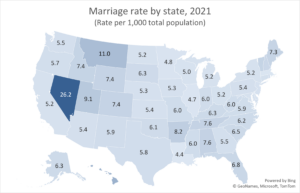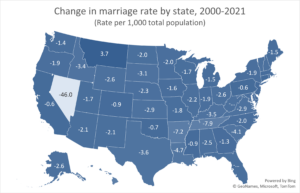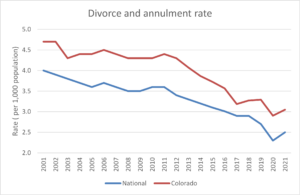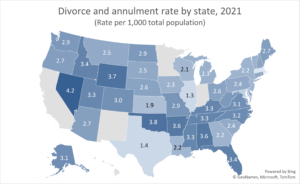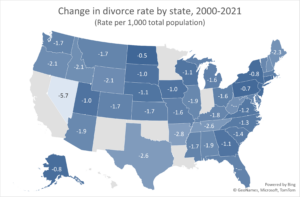Marriage and Divorce Statistics in the United States
Welcome to Griffiths Law P.C. Searching the internet to learn about marriage and divorce trends? You are not alone. We have consolidated the research into one convenient place. Keep reading to learn about marriage and divorce rates across the nation.
The Center for Disease Control and Prevention compiles statistics concerning marriage and divorce in the United States. Most statistics that you will see on the internet are derived from the CDC’s numbers. Marriage and divorce rates are expressed in the number of marriages or divorces per 1,000 population per year. The term “per 1,000 population” means occurrences per 1,000 people, including married and unmarried people, children, and adults. The CDC’s most recent statistics are from 2021.
Marriage Statistics
The average marriage rate across the United States was 8.2 marriages per 1,000 population in 2001. The rate fell to 6.1 in 2019 and 5.1 in 2020, then rose to 6 in 2021 as Covid restrictions lifted. The rate in Colorado was 8.2 in 2001, then 6.7 in 2020, rising to 7.4 in 2021. Nevada has the highest marriage rate in the country, with a rate of 69.6 in 2001 that eventually fell to nearly a third of that to 21 in 2020 and rose to 26.2 in 2021. Hawaii comes in at a distant second, with a rate of 19.6 in 2001, falling to 7.4 in 2020, and then rising to 12.8 in 2021. In the last 30 years, Nevada had the highest marriage rate of 99 in 1990. Louisiana has the lowest marriage rate in the country at 4.4 in 2021. Destination weddings certainly account for the high marriage rates in Nevada and Hawaii, with couples eloping to Las Vegas for drive-through weddings (starting at $89) or saying “I do” to a dreamy beach wedding in Hawaii.
In 1950, 23% of adults ages 15 and older had never married. That number rose to 32% in 2019.
Divorce Statistics
We have all heard that 50% of marriages end in divorce. The source of that figure is impossible to track down. One statistic comes close, with qualifications. According to the Center for Disease Control, 53% of first marriages of more than 20 years of duration among women ages 15-44 ended, either by separation, divorce, or death.
Several states do not report divorce statistics, but among those that do, the average divorce rate in 2000 was 4 divorces per 1,000 population for that year. The rate fell to 2.5 per population in 2021. If you recall, “per 1,000 population” means occurrences per 1,000 people, including married and unmarried people, children, and adults, so that figure would be lower if we only considered married people.
Before other states modernized their divorce laws, the availability of “quickie divorces” made Nevada a divorce-tourism destination. In 1990, Nevada’s divorce rate of 11.4 was the nation’s highest in the last 30 years. But no-fault divorce has become the norm in most states, including Colorado, meaning that an unhappy husband or wife can obtain a divorce without proving that a spouse’s legal wrongdoing ended the marriage. For that reason, more parties are seeking divorce in their home states rather than travelling to Nevada. Nevada’s divorce rate fell to just 3 in 2020, rising to 4.2 in 2021. Colorado’s rate was 5.5 in 1990, falling to 2.9 in 2020, and rising slightly to 3 in 2021. Massachusetts has the nation’s lowest divorce rate at 1 in 2021. Oklahoma had the nation’s highest rate at 3.8 in 2021. States that tend to have higher divorce rates also tend to have lower average incomes, and the reverse is true as well.
If you are contemplating marriage but worried about divorce, you should know that while statistics are interesting because they show trends in the population, statistics cannot predict whether your marriage will work for you. Please talk to one of our lawyers about steps you can take to protect your finances in case of divorce. Having a well-written premarital agreement makes divorce easier and less expensive.
Divorces in Colorado:
Photo credit: https://www.cnn.com/travel/article/aspen-colorado-non-skiers/index.html
If you are divorcing in Colorado, the good news is that Denver, Colorado is the fourth-best city in the country for life after divorce, according to the New York Times. This ranking considers the strength of the economy, the dating pool, and the “re-marriage risk.” The re-marriage risk considers the number of people who have been remarried at least three times.
Seniors and Divorce
The city with the highest senior divorce rate in the United States is Denver, Colorado. According to Census Bureau data from 2018, 28 percent of Denver residents aged 65 and older are divorced.
Seniors who are financially dependent on their spouses have limited opportunities to increase their earning potential, and retirement is a significant change in most couples’ financial situations. While seniors’ finances might be more complicated than those of younger generations, most seniors do not have to address the difficult and complicated issue of parenting young children after divorce. Seniors who are contemplating divorce should speak with an attorney to get a realistic idea of how divorce could financially impact them.
Cohabitation versus Marriage
In 2019, 7% of adults over the age of 18 cohabitated outside of marriage, up from 6% in 2009.
Same Sex Relationships and Marriage
In June of 2015, in Obergefell v. Hodges, the United States Supreme Court held that same-sex couples had the Constitutional right to marry. At that time, about 242,000 married, same-sex couples lived in the United States. By March of 2020, that number had risen to an estimated 513,000.
The divorce rate for same-sex couples is about 1.1% lower than that of heterosexual couples.
Our firm has long supported marriage equality. Whether you are beginning or ending a marriage or committed relationship, our lawyers can help you protect your financial interests.
Conclusion
We hope you found this article and the respective statistics of interest as you determine whether to pursue marriage or to end it. If you need legal counsel, please reach out to us here at Griffiths Law. An experienced attorney can help you decide whether to stay in your marriage or seek a divorce. An attorney’s advice can empower you to make the best decision for yourself in your unique circumstances.

